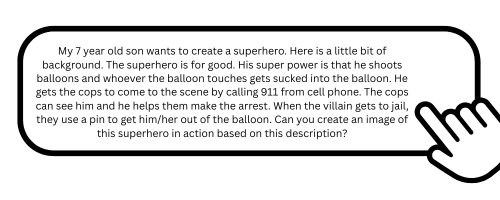Character to Costume
Turn your child's imagination into wearable adventures
What I expected vs. what actually happened
I had this idea for an AI activity for my kids. I wanted them to create a character (in this case a superhero) that didn’t exist yet. I wanted to use AI to help bring their vision to life. Then, once they had an image they like, I wanted AI to provide them instructions on how to create a costume. Perfect example of Idea → AI → Play™ in Action.
What I expected: 10 minutes describing characters, AI generates images, they dress up. Done in 30 minutes.
What actually happened: Jackson spent 15 minutes crafting his superhero's powers, backstory, and nemesis. When AI got it wrong (repeatedly), they didn't accept it—they directed it to match their vision. The costume building took over an hour. Total time: 3+ hours. And they loved every minute.
The Moment That Made Me Stop and Pay Attention
"It has blue gloves, but I don't. That's okay—I'll just use what I have."
Austin's AI-generated character had blue gloves. He looked at the image and said that. That's exactly what I want kids to learn about AI—not "I need what AI showed me," but "AI gave me an idea. Now I'll make it my own."
The first AI attempt to match Jackson’s vision. He then decided he wanted to turn the superhero into an alien.
Why this demonstrates Idea → AI → Play™
IDEA (kids lead)
Kids spend significant time developing their character before AI gets involved. Their imagination comes first. I had told my kids we were doing this activity. I can’t believe how much they thought about their characters before we started. It was really fun learning what they had in their heads.
AI (tool in the middle)
AI helps visualize what they've imagined. It usually gets it wrong the first time and that's perfect. They learn to direct the technology.
PLAY (bring it to life)
The costume building brings it together. AI gave very direct instructions, and my kids used some of the directions to come up with their own idea on how they would build a costume. I was actually surprised how much they did on their own given they had very detailed directions from AI.
The teaching moments
-
Jackson wanted "ET as a superhero." I explained we couldn't copy ET. Without missing a beat: "Okay, what if we make someone who is an alien like ET is but has different powers?"
-
First AI image? Wrong. Second try? Still not right. Third attempt? Getting closer. Kids learn that good results come from refinement.
-
AI suggested "balloon blaster apparatus arms." Jackson's response? "I'll use my spider web shooters! Can I use paper towel rolls?" When I said we didn’t have any: "Maybe we can roll up cardboard instead."
The activity run-down
What You'll Need
AI tool with image generation (ChatGPT works best)
Device with larger screen
30-60 minutes for storytelling
Household supplies: cardboard, tape, markers, old clothes, fabric scraps
Don't rush out to buy supplies—the constraint is part of the learning
Most important: Patience for storytelling (don't rush!), willingness to let them build it "wrong," and comfort with iteration.
How to Facilitate the activity
① Story development
Start with: "Do you want to create a superhero or a villain?"
Then let them talk. Ask questions: "What's their name?" "What are their powers?" "Who is their enemy?" “How did they get to be a superhero?”
Important: Let them say "I don't know" to some questions.
② First AI generation
Build your prompt together: "My [age]-year-old wants to create a [superhero/villain]. Here's the description: [THEIR STORY]. Create an image of this character in action."
③ Iteration
Show them the image and ask: "Is this what you imagined?" The answer will almost always be "not exactly." This is perfect. Keep iterating until they say "Yes! I love it!".
④ Costume design
Once they love the image, ask AI for costume ideas. Then ask: "What else could we use?" Let them problem-solve.
⑤ Build, wear, and play
Step back and let them create. Help with scissors/hot glue when needed. Ask questions. Celebrate creative solutions. Don't fix it to match the AI image.
Skills that will be developed (Outside of AI)
-
Creating coherent character backstories and understanding cause and effect
-
Articulating their vision clearly and giving specific feedback
-
Evaluating AI output and identifying what needs to change
-
Adapting when supplies don't match and finding creative substitutions
-
Their ideas have value and they can direct technology
Why This Matters for Their Future
We're preparing kids for a world where AI collaboration will be normal. The kids who thrive will be the ones who know how to direct AI toward their goals, evaluate and improve AI suggestions, and adapt when technology doesn't perfectly match their needs.



